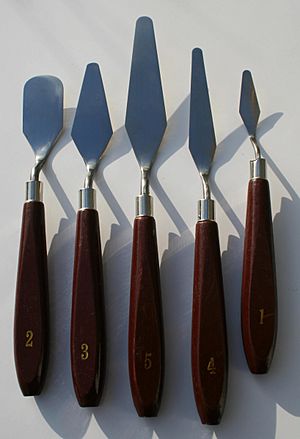Palette knife facts for kids
A palette knife is a cool tool that artists and sometimes even chefs use! Even though it has "knife" in its name, it's not sharp at all. Instead, it has a flexible blade, usually made of steel, and it's used for mixing, spreading, and applying different materials. Think of it more like a tiny, bendy spatula for art!
Contents
What is a Palette Knife?
A palette knife is a handheld tool with a thin, flexible blade. This blade is usually made from steel, but it can also be made from plastic. The blade is attached to a handle, which is often made of wood or plastic, making it comfortable to hold. Unlike a regular knife, a palette knife has no sharp edges and is designed to be very flexible. This flexibility is super important for how it's used.
Parts of a Palette Knife
A palette knife has a few main parts:
- Blade: This is the flat, flexible part that does all the work. It can be long, short, wide, or narrow, and it comes in many different shapes.
- Neck: This is the part that connects the blade to the handle. It's often bent or angled, which helps keep your hand out of the paint or other materials you're working with.
- Handle: This is where you hold the knife. It's designed to be ergonomic, meaning it fits well in your hand for comfortable use.
How Artists Use Palette Knives
Artists use palette knives for many different things, especially when working with paint, like oil paint or acrylic paint.
Mixing Colors
One of the most common uses for a palette knife is mixing paint colors on a palette. Instead of using a brush, which can get paint stuck in its bristles, a palette knife makes it easy to scoop, mix, and blend colors together. The smooth blade ensures that colors are mixed thoroughly and cleanly. After mixing, it's super easy to wipe the knife clean, ready for the next color.
Applying Paint and Creating Texture
Palette knives are also fantastic for applying paint directly to a canvas or other surface. This is where their flexibility and unique shapes really shine!
- Thick Paint: Artists can use a palette knife to apply thick layers of paint, creating a style called impasto. This makes the artwork have a cool, bumpy texture that you can actually see and feel.
- Texture Effects: You can drag, scrape, or dab the knife on the canvas to create all sorts of interesting textures, lines, and patterns that are hard to achieve with a brush. It's great for making rough surfaces, like rocks or tree bark, or even smooth, flat areas.
- Spreading and Smoothing: Just like spreading butter on toast, artists can use the knife to spread paint evenly across a surface or to smooth out areas.
Scraping and Cleaning
Because of its flat blade, a palette knife is also useful for scraping dried paint off a palette or cleaning up excess paint from a canvas. It's a handy tool for keeping an artist's workspace tidy.
Different Types and Shapes
Palette knives come in a huge variety of shapes and sizes, each designed for a specific purpose. Some have long, thin blades, while others are short and wide. Some are pointed, and others are rounded. The shape of the blade affects how the paint can be applied and what kind of marks it can make. Artists often have a collection of different palette knives to achieve various effects in their artwork.
Beyond Painting: Other Uses
While palette knives are famous in the art world, similar tools are used in other areas too!
- Baking and Cooking: In the kitchen, tools very similar to palette knives, often called offset spatulas, are used to spread frosting on cakes, smooth batters, or lift delicate pastries.
- Sculpting: Sculptors might use tools similar to palette knives to shape and smooth clay or other sculpting materials.
- Crafts: In various crafts, these tools can be used for spreading glues, pastes, or other mediums.
So, a palette knife is much more than just a "knife" for artists; it's a versatile and essential tool for creativity!



